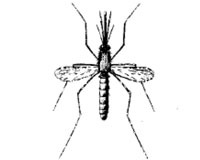6.2.1 Malaria vectors

As you learned in the Study Session 5, not all mosquitoes transmit malaria – only Anopheles mosquitoes (Figure 6.3) can carry the malaria parasite. In Ethiopia there are about 40 different species of Anopheles mosquitoes, but only four of them are known to transmit malaria parasites, and just one of them, Anopheles arabiensis, is responsible for more than 95% of malaria transmissions.
Different species of Anopheles mosquitoes differ in their capacity to transmit malaria. This depends on the biology and behaviour of the mosquitoes. Mosquitoes in the Anopheles gambiae group (which includes A. arabiensis), are the most efficient malaria vectors in the world. These mosquitoes are found only in Africa. In fact, the higher incidence of malaria in Africa compared to other parts of the world is mainly due the efficiency of these mosquitoes in transmitting the parasites.
Mosquitoes need a blood meal to develop and reproduce. They can take their blood meal either from humans or animals. Mosquitoes that mainly feed on humans are more efficient carriers of malaria than those that feed on animals.
One reason why mosquitoes in the A. gambiae group are very good vectors of malaria is that they prefer to bite humans more than animals. Mosquitoes that feed on humans and animals equally are much weaker vectors of malaria. Others feed exclusively on animals and are not malaria vectors. Therefore, the type of Anopheles mosquitoes and their feeding behaviour influence the intensity of transmission in an area.
Your knowledge and practical skills in identification of important breeding habitats in your village will be very helpful in your malaria prevention activities.
Mosquitoes adapted to breeding close to human settlements, and able to breed in a wide range of environments, are also better vectors of malaria than mosquitoes that breed away from human habitation. Some mosquitoes breed in small pools that are partially or completely exposed to the sun, while others prefer to breed in shaded stagnant pools. A. gambiae mosquitoes breed in a wide range of habitats, including small water collections such as hoof-prints, water-filled holes in rocks and trees, as well as dams, river beds and lake shores. Because A. gambiae vectors can breed in so many different habitats, they are responsible for much of the malaria transmission in Africa.
The main vector of malaria in Ethiopia, A. arabiensis, can be found in a variety of water collections, mainly closer to human habitations. However, stagnant water collections in borrow pits, ponds, micro-dams, pools in small rivers, and streams created immediately after the rainy season, are the most important breeding habitats for this vector.
6.2 Non-climatic factors
